My Vox Grey Wah Clone
Last updated 12/27/05 by Paul Marossy
One day, I decided to build one of these mysterious Vox grey Wah Wah circuits because I wanted
to learn more about them without having to spend $700-1200 on ebay to get my hands on one. Jimmy
Page faithfully used one of these wah pedals, so I thought it might be worth a little further
investigation to see what was special about it. The circuit is virtually the classic wah circuit, but the
500mH inductor has been replaced with a nominal 250mH inductor and the 33K resistor in parallel
with the inductor is absent. This 33K resistor can be found on some examples, though. Most
people that have actually played one say that it doesn't sound that good on its own - more
like a treble sweep - but it can nail the Jimmy Page tone when pushing a fuzz box.
I used my
Vox V846 PCB layout
to whip up the circuit in a couple of hours. I used tropical
fish caps in it and some BC109 transistors with an Hfe of around 400, which makes it consistent
with the 2N3707s found in the original. Since a 250mH inductor does not
appear to be too easy to find, I used a 370mH inductor from an old RadioShack EQ which has a
DC resistance of about 125 ohms. I placed the circuit in a cheap wah shell made by "Stageworks"
and finished up the wiring. The shell is a chrome plated replica of the original CryBaby shell,
and with a little help, it works just as well. It cost $33 plus shipping from a seller on ebay.
In terms of how it sounds, it actually sounds pretty good as is, maybe a little on the
trebly side with it at the extreme treble end, but it responds really well to rolling back
the tone control on my guitar a little bit. It sounds really good with a Marshall amp kind of
distortion, too. The amount treble is easily adjusted by changing the points where the pot begins
and ends its rotation. Overall, I think it's a keeper. It kind of has a unique sound that I like, and
in fact is one of the few wah pedals I have played that sounds good with a humbucker in the neck position.
Maybe that's why Jimmy Page liked it?
I decided to experiment with some different resistance values in parallel with the inductor for
kicks. Now, I know that the "ideal" inductor for the standard wah circuit is 500mH with a DC
resistance of around 60-85 ohms, but there seems to be room for inductors with a lesser Q
than all the reading I have done has led me to believe. According to the original wah patent
text, the circuit has a very high Q, so it appears that it can stand an inductor that's
far less than perfect - at least to my ears. In this case, maybe I just got lucky.
But, I am still looking for a 250mH inductor to try. Anyhow, I tried a 47K resistor in series with a 50K pot
connected in parallel with the inductor and found that there is a rather small range before you almost lose the wah
effect entirely. Then I noticed one interesting thing while looking at the
original wah patent
- it doesn't show a resistor in parallel
with the 500mH inductor. That was apparently added at a later date, after the patent
was submitted. So, armed with this information, I can only assume that the 33K resistor was
added because the Q of the circuit was still too high, and this was their solution to bring it
down some.
This little experiment has shown me that the resistor in parallel with the inductor is pretty
important to how vocal the pedal sounds. Make it too big, and it'll become mute! I think in
my case, since the inductor is a 370mH with a DC resistance of 125 ohms, the Q is low enough
already for it not to become an issue. Taking this a little further, it may be possible to use
the RadioShack transformers as suggested at
geofex.com
to good effect by adjusting the size of or omitting
the resistor in parallel with the inductor. Your results may vary.
Below are some more details on this project.
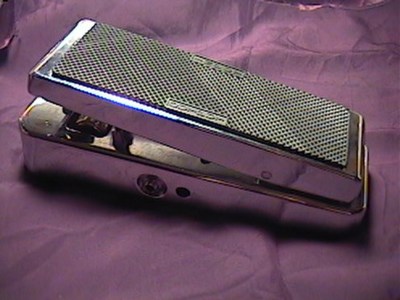 |
Here is the wah pedal shell that I used. It's an almost exact copy of the original wah pedal shell. I removed the pin that holds the foot pedal on the shell and smoothed up the mating surfaces to make things operate as smooth as possible. |
 |
I made a little nameplate to cover up the original one. I used AutoCAD to create the graphics. |
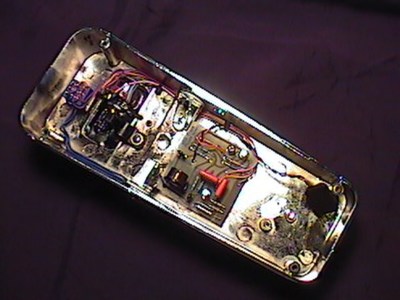 |
Here's the inside showing the new circuit board and wiring. It's wired for true bypass. |
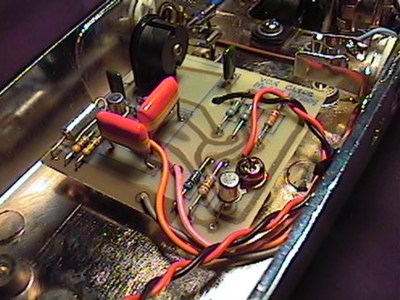 |
This is the PCB. I etched the board using one of those RadioShack PCB kits. I will never buy one of those kits again - the PCB is only about 1/64" thick and the Ferric Chloride is the worst that I have ever used! The kits I have used in the past have all yielded acceptable results, but this has gotten to be ridiculous. Anyhow, it worked out OK. |
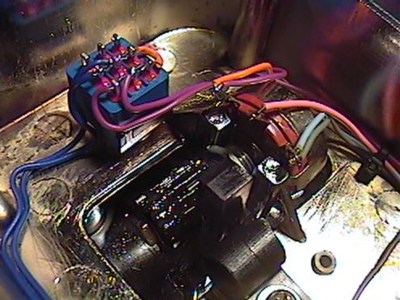 |
Cheap as it is, the wah pedal also comes with a 100K 2-watt heavy duty pot similar to what you may find in the original wah pedals. However, the feel of the pedal just wasn't as smooth as I'm used to. I got to looking at it closer and found that the gear attached to the pot shaft has 2 to 3 more teeth than what is used in a geniune CryBaby. This makes the feel considerably different - it makes it feel like you have to work harder to get the same effect. I substituted it with a Dunlop gear, and now it feels just like the rest of my wah pedals. I wouldn't have thought that something that simple could have such a large effect, but it does. |
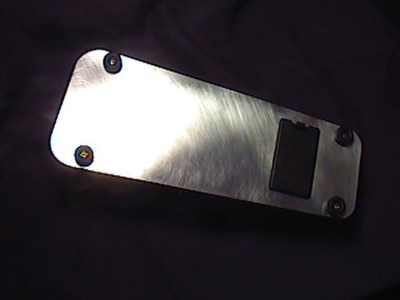 |
This is the bottom. I simply flipped the bottom cover over so the graphics are hidden. |
Well, that has satisfied my curiousity about the circuit and in several other different areas. Next on the list of things to do is to build a Schaller " Bow Wow Yoy Yoy " clone to experiment with. The PCB is already etched but I need to track down a 100K reverse log pot to complete it. My "wah trek" continues...